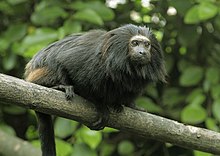Lion tamarin
| Lion tamarin | ||||||||||||
|---|---|---|---|---|---|---|---|---|---|---|---|---|

Golden-headed lion tamarin ( Leontopithecus chrysomelas ) |
||||||||||||
| Systematics | ||||||||||||
|
||||||||||||
| Scientific name | ||||||||||||
| Leontopithecus | ||||||||||||
| Lesson , 1840 |


The lion tamarins ( Leontopithecus ) are a genus of the marmoset family (Callitrichidae). All four species live in southeastern Brazil and their population is threatened.
features
Lion tamarins are the largest representatives of the marmosets. They reach a head body length of 20 to 34 centimeters, in addition there is the 30 to 40 centimeter long tail. Their weight is around 500 to 600 grams. Their thick, silky fur is colored black or golden yellow, depending on the species, and sometimes has a pattern. The name-giving feature is the mane-like hair in the shoulder area. Their faces are flat and hairless. As with all marmosets, the fingers and toes (with the exception of the big toe) have claws instead of nails.
Distribution and way of life
Lion tamarins live exclusively in southeastern Brazil . Their distribution area includes the southern Bahia , Rio de Janeiro , São Paulo and the north of Parana . The habitat of these animals are the Atlantic rainforests , especially in the lowlands near the coast.
Way of life
Lion tamarins are diurnal, when they sleep they retire in tree hollows or in the plant thicket. They mainly stay in the trees and prefer areas with dense vegetation with climbing and creeping plants. They move around on all fours, but they can also jump well.
Lion tamarins live in small groups of usually three to seven animals. The groups are either family groups with their offspring or can contain several adult males and females. There is pronounced social behavior within the group: mutual grooming and sharing of food play an important role. The individual animals in the group usually stay in visual contact and communicate with one another by screaming. The 40 to 70 hectare territory is defended against foreign animals with shouting or aggressive facial expressions.
food
Lion tamarins are omnivores that eat both animal (insects, spiders, snails, bird eggs and small vertebrates) and plant foods (mainly fruits).
Reproduction
Only one pair reproduces within a group, even if there are several adult animals of the same sex. After a gestation period of 120 to 130 days, the female usually gives birth to twins. The whole group takes part in raising the young, but primarily the father. The cubs are weaned at three months and sexually mature at 18 to 24 months. Due to the social structure, the animals only reproduce later for the first time.
The life expectancy of lion tamarins is up to 18 years.
Danger
The lion tamarins ' natural enemies include leopards , snakes and birds of prey . The main threat, however, is the destruction of their habitat. The rainforests of south-east Brazil are more severely affected by deforestation than others; only a fraction of the forests in this region exist. In addition, the animals are often caught illegally and sold as pets on the black market. That is why lion tamarins are one of the most threatened primate species. All four species are threatened, the black-headed lion tamarin is critically endangered according to the IUCN .
Systematics
The lion tamarins are divided into four types [in square brackets, the distribution area in the map on the right]:
- The golden lion tamarin ( Leontopithecus rosalia ) has a completely golden yellow fur [red].
- The golden-headed lion tamarin ( Leontopithecus chrysomelas ) has a black body, only the mane and front paws are golden [yellow].
- The red- tipped lion tamarin ( Leontopithecus chrysopygus ) is almost entirely black, only the buttocks region is red-brown in color [light blue].
- The black- headed lion tamarin ( Leontopithecus caissara ) has a yellow body, only the mane, the paws and the tail are colored black [black (in the circle)].
literature
- Thomas Geissmann : Comparative Primatology. Springer, Berlin a. a. 2003, ISBN 3-540-43645-6 .
- Ronald M. Nowak: Walker's Mammals of the World. 6th edition, Johns Hopkins University Press, Baltimore MD 1999, ISBN 0-8018-5789-9 .
